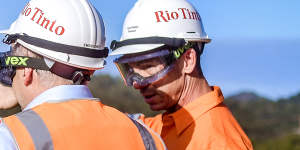The Anglo-Australian mining giant is one of the largest electricity users and heaviest emitters of carbon dioxide on the nation’s eastern seaboard due to its aluminium smelters and alumina refineries in New South Wales and Queensland.

Prime Minister Anthony Albanese visiting Rio Tinto’s Yarwun alumina refinery near Gladstone.Brenda Strong
While hydroelectric dams power many of Rio Tinto’s smelters globally,its Boyne and Tomago operations in Australia run off coal-based electrical grids,posing one of the biggest hurdles to Rio Tinto’s push to halve emissions by 2030. Last year,the company kicked off a process of seeking bids to develop four gigawatts of wind and solar farms,backed up by “firming” assets such as big batteries or gas,to decarbonise its Pacific Aluminium division.
The size of the build-out of new renewables the company is targeting equates to roughly one third of Australia’s present wind and large-scale solar capacity. Rio Tinto chief executive Jakob Stausholm said it was a key priority for him and his leadership team,“but it’s not easy”.
“The Pacific Aluminium assets are massive – some are some of the biggest basic manufacturing industry that we’ve got in Australia – and I feel a deep responsibility to our employees to find a viable future for those assets,” he said.
“But... we cannot just carry on. We have to find a way to decarbonise those assets and for it to be done competitively,so we can generate a viable future for those assets.”
Rio Tinto argues that a “coordinated grid solution” in Queensland will be critical and will require collaboration between suppliers,users,regulators,transmission providers and policymakers.
Stausholm said renewable energy projects,much like new mines,came with long lead times for planning,approvals and development. He said the challenge in securing urgently needed new projects on the scale required was being felt across the globe.
“It’s becoming clear that the world has some ambitious targets on climate change,but the world is struggling to develop renewable energy fast enough,” he said.
“We’ve got plenty of energy in terms of fossil fuels,but the trick is how fast you can phase that out.”
The Boyne aluminium smelter in Queensland is powered by the Gladstone coal-fired generator,which Rio Tinto part-owns. Delivering its full-year profit results last week,the miner wrote down the smelter’s value to zero after soaring global coal prices pushed up the cost of running the power plant.
Underlying earnings across the Pacific Aluminium division fell from $US426 million to $US248 million during 2022.
Tyler Broda,an analyst with the Royal Bank of Canada,described Rio Tinto’s group profits for the full year as largely in line with expectations,with “higher cost inflation in aluminium driving a very small miss”.
Rio Tinto’s Pacific Aluminium division is among the large industrial emitters across the country that face binding pollution caps from July under the Albanese government’s signature climate policy,the “safeguard mechanism”.
The 215 facilities captured by the safeguard mechanism,which include sites such as coal mines,gas-processing plants,manufacturing firms and steel mills,are responsible for 28 per cent of the nation’s greenhouse emissions. They will be required to reduce emissions by at least 4.9 per cent a year,or 30 per cent by 2030,through either adopting cleaner technology or investing in greenhouse offsets.
Federal Climate Change and Energy Minister Chris Bowen said the proposed reforms had been “carefully calibrated to deliver the policy certainty and support Australian industry needs through decarbonisation”.
Rio Tinto has been a vocal backer of the government’s plan,saying the increased level of climate ambition was aligned with the company’s own targets.
The Australian Aluminium Council,an industry group representing bauxite miners,alumina refiners and aluminium smelters,has told the government that more work is needed on how the scheme will treat trade-exposed industries to avoid reducing their competitiveness and pushing operations offshore to countries with weaker emissions rules.”The council seeks a national climate and energy policy framework which is equitable,transparent,stable and predictable,while maintaining the economic health of the nation where import and export competing industries hold a vital role,” it said. “The Council wishes to continue to work with the government to achieve optimal outcomes for the Australian industry,through 2030 and beyond.”
The Business Briefing newsletter delivers major stories,exclusive coverage and expert opinion..